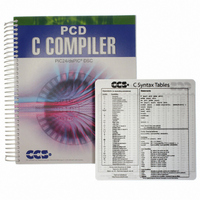PCDIDE COMPILER Custom Computer Services Inc (CCS), PCDIDE COMPILER Datasheet - Page 342

PCDIDE COMPILER
Manufacturer Part Number
PCDIDE COMPILER
Description
PCD C-COMPILER PIC24, DSPIC
Manufacturer
Custom Computer Services Inc (CCS)
Type
Compilerr
Datasheet
1.PCD_COMMAND_LINE_COMPILER.pdf
(373 pages)
Specifications of PCDIDE COMPILER
For Use With/related Products
Microchip PIC24/dsPIC®
Lead Free Status / RoHS Status
Not applicable / Not applicable
Other names
429-1008
- Current page: 342 of 373
- Download datasheet (4Mb)
PCD C Compiler Reference Manual January 2011
Explicit conversion may be done at any point with (type) inserted before the expression to be
converted. For example in the above the perhaps desired effect may be achieved by doing:
i32 = i16 - ((long)i8 + i8)
In this case the first i8 is converted to 16 bit, then the add is a 16 bit add and the second i8 is
forced to 16 bit.
A common C programming error is to do something like:
i16 = i8 * 100;
When the intent was:
i16 = (long) i8 * 100;
Remember that with unsigned ints (the default for this compiler) the values are never negative. For
example 2-4 is 254 (in 8 bit). This means the following is an endless loop since i is never less than
0:
int i;
for( i=100; i>=0; i--)
How can a constant data table be placed in ROM?
The compiler has support for placing any data structure into the device ROM as a constant read-
only element. Since the ROM and RAM data paths are separate , there are restrictions on how the
data is accessed. For example, to place a 10 element BYTE array in ROM use:
BYTE CONST TABLE [10]= {9,8,7,6,5,4,3,2,1,0};
and to access the table use:
x = TABLE [i];
OR
x = TABLE [5];
BUT NOT
ptr = &TABLE [i];
In this case, a pointer to the table cannot be constructed.
Similar constructs using CONST may be used with any data type including structures, longs and floats.
328
Related parts for PCDIDE COMPILER
Image
Part Number
Description
Manufacturer
Datasheet
Request
R

Part Number:
Description:
PROTOTYPING BOARD FOR PIC MCU
Manufacturer:
Custom Computer Services Inc (CCS)

Part Number:
Description:
Extra CCS C Manual
Manufacturer:
Custom Computer Services Inc (CCS)

Part Number:
Description:
MACH X Programmer
Manufacturer:
Custom Computer Services Inc (CCS)

Part Number:
Description:
PCD For 24-bit (PIC24/dsPIC)
Manufacturer:
Custom Computer Services Inc (CCS)

Part Number:
Description:
LOAD-n-GO Programmer
Manufacturer:
Custom Computer Services Inc (CCS)

Part Number:
Description:
EMBEDDED INTERNET DEVELOPMENT KIT W/PCWH
Manufacturer:
Custom Computer Services Inc (CCS)

Part Number:
Description:
PIC24F Development Kit With PCWHD
Manufacturer:
Custom Computer Services Inc (CCS)

Part Number:
Description:
PIC24F Development Kit With PCDIDE
Manufacturer:
Custom Computer Services Inc (CCS)

Part Number:
Description:
PIC24H Development Kit With PCWHD
Manufacturer:
Custom Computer Services Inc (CCS)

Part Number:
Description:
USB Master Prototyping Board
Manufacturer:
Custom Computer Services Inc (CCS)










